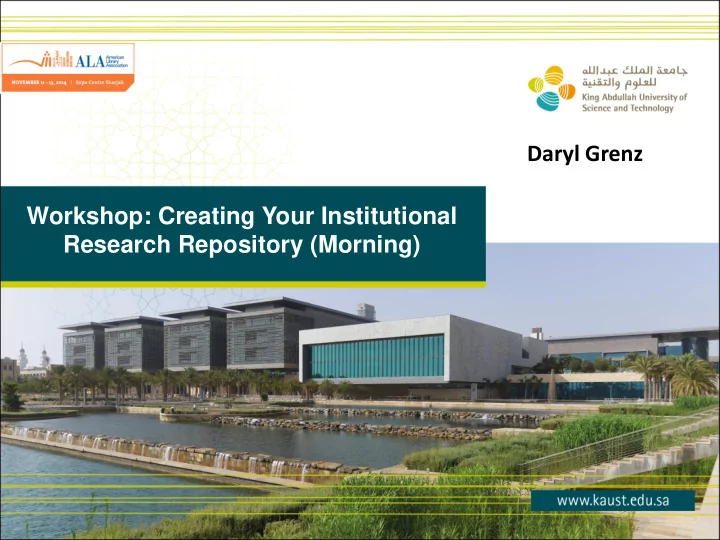

Daryl Grenz Workshop: Creating Your Institutional Research Repository (Morning)
Schedule Morning: 10-11: Scholarly communications environment and repository landscape --- Break --- 11:10-12:30: Planning for services and infrastructure ____________________________________________________________ --- Lunch --- ____________________________________________________________ Afternoon: 1:30-2:30: Recruiting content and understanding permissions issues --- Break --- 2:40-3:40: Open access policies and metadata exchange --- Break --- 3:50-5:00: Added value services, marketing and training
Expected Takeaways Improved understanding of trends in scholarly communication and repository services Ideas for specific repository services appropriate for your institution Connections with colleagues in support of regional collaborative efforts
Daryl Grenz What are scholars doing? How are they communicating it? How is it being assessed?
Scholarly Communication The ways in which academics, scholars and researchers share their research within their communities, and assess the validity and importance of the research of others: Have developed into norms over time Differ across disciplines Are changing in response to cultural, economic and technological factors
Scholarly Communication Traditional Features: Classroom-based teaching In-person lectures Textbook purchase required Innovative Trends: Partially or entirely online courses (MOOCs, etc.) Video lectures Open textbooks Repository content: Open educational resources, syllabi, exam papers, etc.
Scholarly Communication Traditional Features: Posters and presentations at society conferences Abstracts available in proceedings Innovative Trends: Webinars, livestreaming or recording of presentations Online conferences (Library 2.0 - http://www.library20.com ) Slides on Slideshare Repository content: Slides, poster files, presentation recordings, abstracts Integration with OCS: Open Conference System from PKP o https://pkp.sfu.ca/ocs/
Scholarly Communication Traditional Features: Blind, pre-publication peer review Publication in subscription journals and proceedings Innovative Trends: Open peer review Post-publication peer review Publication on preprint servers or in open access journals Repository roles: Integration with OJS: Open Journal System from PKP (https://pkp.sfu.ca/ojs/ ) Peer review module for Dspace: http://duraspace.org/node/2824
Scholarly Communication Traditional Features: Focus on producing expository text Supporting information available upon request or as supplemental files Innovative Trends: Structured nano or micro-publications Treatment of software and data as “first class” outputs Data citation, FAIR principles ( http://www.nature.com/articles/sdata201618 ) Open protocols, visualized experiments, open science workflows and collaborative platforms (https://osf.io ) Repository content: Datasets, code, videos, images, etc.
Scholarly Communication Traditional Features: Citation-based metrics to measure impact Impact factor, H-index, etc. Innovative Trends: Alternative metrics (Altmetrics) Downloads, views, news mentions, social media attention Repository-related: Identify impacts of repository content that does not typically receive citations in formal publication
Daryl Grenz Where did repositories come from? Where are they going?
Repository Landscape Pre-print servers Disciplinary repositories Institutional repositories Data repositories Current research information systems National and regional repositories Aggregators
Preprint Servers arXiv – since 1991 Physics, mathematics, computer science. SSRN – since 1994, purchased by Elsevier in 2016 Social sciences, law, humanities RePec – since 1997 Economics bioRxiv – since 2013 Biology Open Preprint Repository Network (OSF) – 2016 https://osf.io/preprints/
Disciplinary Repositories PubMed Central https://www.ncbi.nlm.nih.gov/pmc/ Since 2000 To support NIH open access policy Now also: Europe: http://europepmc.org Canada: http://pubmedcentralcanada.ca/pmcc/ E-LIS - Library and information science repository: http://eprints.rclis.org/ List by discipline (including preprint servers) http://oad.simmons.edu/oadwiki/Disciplinary_repos itories
Institutional Repositories Early basis in open source software: Some of the earliest repositories at University of Southampton (Eprints – 2000) and MIT (DSpace – 2002). Now over 3000 institutional repositories worldwide See directories at: o OpenDOAR: http://www.opendoar.org/find.php?format=charts o ROAR: http://roar.eprints.org o Global map (last updated in 2014): o http://maps.repository66.org
Data Repositories Over 1500 worldwide : Re3data: http://service.re3data.org/search Primarily disciplinary but increasingly institutional: Disciplinary examples: o NCBI Genbank: https://www.ncbi.nlm.nih.gov/genbank/ o HEPdata: https://hepdata.net Institutional examples: o Harvard Dataverse: https://dataverse.harvard.edu o U of Edinburgh: http://datashare.is.ed.ac.uk Often deposited as result of journal data policy and tied to article publication: Dryad: http://datadryad.org
CRIS and RIMS Focused on institutional reporting needs But can often provide functions that overlap with those of traditional repositories. Primarily commercial platforms: Elsevier Pure: https://www.elsevier.com/solutions/pure Symplectic Elements: http://symplectic.co.uk/products/elements/ Thomson Reuters Converis: http://converis.thomsonreuters.com But DSpace-CRIS has similar functions: https://wiki.duraspace.org/display/DSPACECRIS/DSpace-CRIS+Home Example portal at HKU: http://hub.hku.hk
National and Regional Repository Services France: Open access repository https://hal.archives-ouvertes.fr Netherlands: National CRIS http://www.narcis.nl Australia: National Data Service http://www.ands.org.au Theses: UK: http://ethos.bl.uk/ India: http://shodhganga.inflibnet.ac.in US state consortiums: Texas (TDL) and California (CDL)
Aggregators Primarily based on OAI-PMH and Dublin Core: ETDs: NDLTD Union Catalog: http://union.ndltd.org/portal/ Open Access Theses and Dissertations: https://oatd.org/ BASE: https://www.base-search.net/ OpenAIRE: https://www.openaire.eu CORE: https://core.ac.uk WorldWideScience: http://worldwidescience.org OAIster: http://oaister.worldcat.org SHARE: https://share.osf.io Intending to allow tracking of all “research releases”
Repository Directions More: reporting and profiling functions like those available in commercial CRIS systems. support for research data deposit. support for unique materials (ETDs, grey literature, etc.). modern interfaces and UX. Less: complex submission processes. local hosting and software customization. focus on disrupting subscription publisher business models.
Daryl Grenz Who needs a repository? What do they need it for?
How do repositories thrive? Institutional repositories need to meet specific local needs and provide clear benefits to their stakeholders. Repositories that fail to will not thrive and may die. o http://scitechsociety.blogspot.ae/2016/07/let-ir-rip.html o http://poynder.blogspot.ae/2016/10/institutional-repositories- response-to.html o http://tscott.typepad.com/tsp/2016/09/dialectic-the-future-of- institutional-repositories.html Who will you help and how?
Students? May want to showcase their outputs and connect them to their future academic profile (for example via ORCID): Posters, presentations, code, datasets, portfolio projects, capstone projects, undergraduate papers, undergraduate senior theses, graduate theses and dissertations. May want to access the outputs of their advisors or of students who preceded them in the program. How do you know what would be most useful to them? A good place to start is to ask them. Can you identify who would be good student representatives to talk to at your institution?
Faculty? May want to showcase their outputs and connect them to their past academic profile (for example via ORCID and on their university profile page): Technical reports, grant proposals, grant reports, posters, presentations, code, datasets, teaching materials, syllabi, exams, patents, conference papers, journal articles, book chapters, books. May want to access the outputs of their students or of faculty who preceded them in the program. How do you know what would be most useful to them? A good place to start is to ask them. Can you identify who would be good faculty representatives to talk to at your institution?
Recommend
More recommend